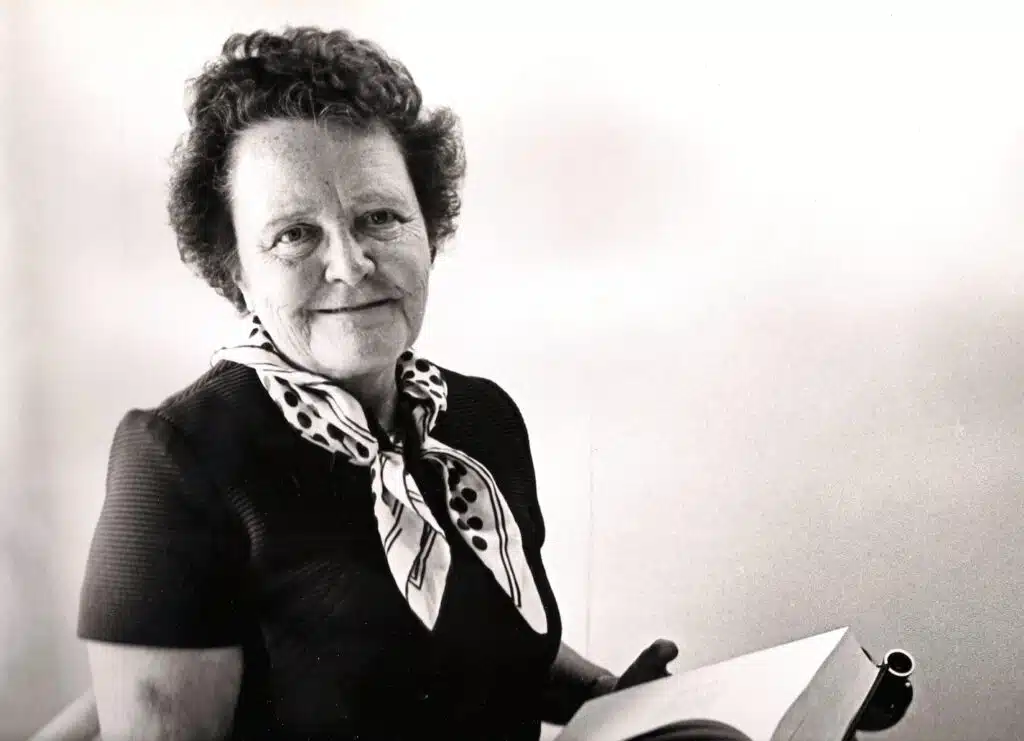
Since 1985, the presidents of the United States have issued a proclamation declaring March as Women’s History Month. This special dedication is to honor the contributions and special achievements of women in various fields throughout American history. This month we wanted to highlight the work of women who paved the way for new generations in both science and conservation. In this week’s blog, we wanted to spotlight the work of botanist and limnologist Ruth Patrick. Born in Topeka, Kansas in 1907, Patrick had a strong interest in the natural world around her from a young age, eventually making a name for herself in the world of stream ecology. Her passion for science began after receiving her first microscope when she was seven years old. Patrick earned a bachelor’s degree in biology from Corker College in South Carolina before completing her master’s (1931) and doctorate (1934) in botany from the University of Virginia.
Before graduating, Patrick began volunteering at the Academy of Natural Sciences of Philadelphia (now associated with Drexel University) and continued volunteering after graduation as a curator where she worked unpaid for the next 12 years. In this role, Patrick consolidated the existing collections of the Diatom Herbarium – single-celled algae – and oversaw its expansion, which is still one of the most important collections at the Academy today. In 1945, Patrick finally became a part of the staff and founded the Department of Limnology (the study of inland waters) two years later. She chaired the department until 1973, which was later renamed as the Patrick Center for Environmental Research in her honor in 1983.

Patrick invented the diatometer, a device used in river surveys that holds microscope slides and can float. Diatoms – single-celled algae – attach to the slides and grow as they would on natural surfaces and ultimately determine the presence of pollution in fresh water. Using this device on numerous river surveys throughout the United States, Ruth firmly established that the taxonomic structure of the diatom community varied with different types of pollution. Using this invention, Patrick was able to create a taxonomic structure of the diatom community with different kinds of pollution. Patrick’s work with diatoms aided military efforts during World War II. A hideaway location of a German sub base was determined when Patrick recognized a particular single-celled algae that grew in the West Indies from a sample scraped off the side of a captured German submarine. The military was able to locate and terminate the sub base using this information from Patrick.
1948 was a major turning point in Patrick’s career when she led a multidisciplinary study of the Conestoga Creek Basin in Lancaster County, Pennsylvania. In her work with diatoms, Patrick observed that species composition of diatoms reflected the health of a stream. This was the first comprehensive survey of the effects of pollution on the plants, animals, and microorganisms in a creek or river, and was the first large-scale test of Patrick’s hypothesis that biodiversity could be used as a measure of pollution. Patrick and her team analyzed sources of pollution, water chemistry, and biodiversity of a large array of organisms from bacteria to fish. What they discovered was that indeed, as pollution increases, biodiversity decreased. This major discovery was declared the “Patrick Principle” by Dr. Thomas Lovejoy. Biological diversity can be used to measure environmental impact and is considered to be the basis of all environmental science and management. Patrick went on to assess more than 800 streams across the world using her techniques.
Patrick had a long and remarkable career. She worked with Congress on anti-pollution legislation and participated in developing the Clean Water Act, the federal law governing pollution and water quality of the Nation’s waterways, which was passed in 1972. She was elected to the National Academy of Sciences in 1970, only the twelfth woman at the time to receive that recognition. Partrick received dozens of awards throughout her career including the Medal of Science in 1996 and 25 honorary degrees. Even at 100 years old, she reported to her office at the Academy of Natural Sciences to continue work on her book series.
Alongside Rachel Carson, Patrick is credited for the worldwide concern for our environment. The legacy of Ruth Patrick continues today. University of South Carolina named the science education center after Patrick along with a wetlands preservation site near the Savannah River in Georgia. Her founding principle still guides stream health assessments today across the nation. Referred to as “a den mother for generations of scientists”, Ruth Patrick’s passion and work ethic paved the way not just for women in science and conservation, but for all ecologists.
References
Bott, Thomas L. & Sweeney, Bernard W. “Ruth Patrick 1907-2013 Biographical Memories”. National Academy of Sciences. 2014. https://www.nasonline.org/publications/biographical-memoirs/memoir-pdfs/patrick-ruth.pdf. Accessed 20 March 2024.
Crable, Ad. “Ruth Patrick’s stream research broke ground – and a glass ceiling or two”. Bay Journal. 30 July 2019. https://www.bayjournal.com/archives/ruth-patrick-s-stream-research-broke-ground-and-a-glass-ceiling-or-two/article_5fd720b5-24c2-5b99-81b3-73d2a021d170.html. Accessed 20 March 2024.
Measler, Tamara A. “Ruth Patrick”. The Philadelphia Award. https://www.philadelphiaaward.org/winners/ruth-patrick/. Accessed 20 March 2024.
“Pioneering Ecologist Dr. Ruth Patrick Dies”. The Academy of Natural Sciences of Drexel University. 23 September 2013. https://ansp.org/about/press-room/releases/2013/ruth-patrick/. Accessed 20 March 2024.
“Ruth Patrick”. National Women’s Hall of Fame. https://www.womenofthehall.org/inductee/ruth-patrick/. Accessed 20 March 2024.
“Ruth Patrick Diatometer Computing and Telecommunications”. Lemelson-Mit. https://lemelson.mit.edu/resources/ruth-patrick. Accessed 20 March 2024.

Brianna Shepherd
Research Specialist
As a research specialist in the Stuble Lab, I am leading the Beech Leaf Disease forest monitoring research project. Started in 2023, this project aims to explore and quantify changes in the forest community as forests are impacted by Beech Leaf Disease. The goal of this study is to better understand the implications of dieback of beech trees for forest health, forest resource availability, and the future composition of forests. As lead on this project, I oversee surveying and data management.












